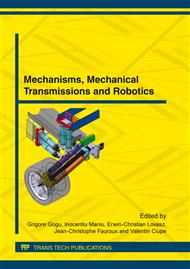[1]
Ming-Kuei Hu. Visual pattern recognition by moment invariants. Information Theory, IRE Transactions on, 8(2): 179–187, (1962).
DOI: 10.1109/tit.1962.1057692
Google Scholar
[2]
M. R. Teague. Image analysis via the general theory of moments. Journal of the Optical Society of America, 70 Issue 8: 920–930, (1980).
DOI: 10.1364/josa.70.000920
Google Scholar
[3]
Alireza Khotanzad and Yaw Hua Hong. Invariant image recognition by zernike moments. IEEE Trans. Pattern Anal. Mach. Intell.
DOI: 10.1109/icpr.1988.28233
Google Scholar
[4]
R. Mukundan, S. H. Ong, and Poh Aun Lee. Image analysis by tchebyshev moments. IEEE Transactions on Image Processing.
Google Scholar
[5]
R. Mukundan. Some computational aspects of discrete orthonormal moments. IEEE Transactions on Image Processing.
DOI: 10.1109/tip.2004.828430
Google Scholar
[6]
C.H. Teh and R.T. Chin. On image analysis by the methods of moments. IEEE Transactions on Pattern Analysis and Machine Intelligence, 10: 496–513, (1988).
DOI: 10.1109/34.3913
Google Scholar
[7]
Chee-Way Chong, P. Raveendran, and R. Mukundan. The scale invariants of pseudo-zernike moments. Pattern Anal. Applications, pages 176–184, (2003).
DOI: 10.1007/s10044-002-0183-5
Google Scholar
[8]
Chee-Way Chong, P. Raveendran, and R. Mukundan. Translation and scale invariants of Legendre moments. Pattern Recognition, 37(1): 119–129, (2004).
DOI: 10.1016/j.patcog.2003.06.003
Google Scholar
[9]
Khalid M. Hosny. Refined translation and scale Legendre moment invariants. Pattern Recogn. Lett., 31: 533–538, May (2010).
DOI: 10.1016/j.patrec.2009.12.008
Google Scholar
[10]
Khalid M. Hosny. New set of rotationally Legendre moment invariants. International Journal of Electrical, Computer, and Systems Engineer-ing, 4: 533–538, May (2010).
Google Scholar
[11]
F. Chaumette. Image moments: a general and useful set of features for visual servoing. IEEE Trans. on Robotics, 20(4): 713–723, August (2004).
DOI: 10.1109/tro.2004.829463
Google Scholar
[12]
O. Tahri and F. Chaumette. Application of moment invariants to visual servoing. In IEEE Int. Conf. on Robotics and Automation, ICRA'03, volume 3, pages 4276–4281, Taipeh, Taiwan, May (2003).
DOI: 10.1109/robot.2003.1242261
Google Scholar
[13]
O. Tahri and F. Chaumette. Point-based and region-based image moments for visual servoing of planar objects. IEEE Trans. On Robotics, 21(6): 1116–1127, December (2005).
DOI: 10.1109/tro.2005.853500
Google Scholar
[14]
K.R. Ramakrishnan R. Mukundan. Moment functions in image analysis: Theory and applications. In World Scientific Publishing Co Pte Ltd., Singapore, page 165, September (1998).
Google Scholar
[15]
S. S. Reddi. Radial and angular moments invariants for image identification. IEEE Trans. Pattern Anal. Mach. Intell.
DOI: 10.1109/tpami.1981.4767087
Google Scholar
[16]
Y.S. Abu Mostafa and D. Psaltis. Recognitive aspects of moment invariants. PAMI, 6(6): 698–706, November (1984).
DOI: 10.1109/tpami.1984.4767594
Google Scholar
[17]
P.I. Corke and S. Hutchinson. A new partitioned approach to image-based visual servo control. IEEE Transactions on Robotics and Automation, 17: 507515, aug (2001).
DOI: 10.1109/70.954764
Google Scholar
[18]
E. Marchand, F. Spindler, and F. Chaumette. Visp for visual servoing: a generic software platform with a wide class of robot control skills. IEEE Robotics and Automation Magazine, 12(4): 40–52, December (2005).
DOI: 10.1109/mra.2005.1577023
Google Scholar
[19]
C. Steger. On the calculation of arbitrary moments of polygons. Technical Report FGBV9605, Technische UniversitM, oct (1996).
Google Scholar


